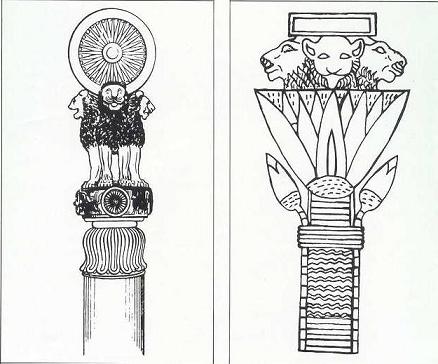
See also post: Egyptian Ma'at Akin to Hebrew Hokmah (Wisdom):
http://easterncivilisationamaic.blogspot.com.au/2012/08/egyptian-maat-akin-to-hebrew-hokmah.html
http://easterncivilisationamaic.blogspot.com.au/2012/08/egyptian-maat-akin-to-hebrew-hokmah.html
Taken from: http://www.hinduwisdom.info/India_and_Egypt.htm#Cultural

Contacts with Egypt
....
Difficult as it is to pin point exactly when
communication between Egypt and India commenced, it is nevertheless intriguing
to note the remarkable parallels which go as far back as the second millennium
BC, if not earlier, between the concept of the Egyptian maat and the Vedic rita
- the divine order of nature or creation, as opposed to the chaos of falsehood.
According to both the Egyptian and Indian traditions, it was the principal duty
of the king to establish order in place of disorder or chaos. Other interesting
points of similarity between the two ancient cultures were the deification of
the forces of nature, faith in magical chants, deep-rooted mysticism, and an
emphasis on symbolic expression.
There is a close proximity between Hindu mythology
and Egyptian mythology and rituals. "The Book of Dead" and Garuda Purana are
similar. Both are recited at the time of death. Their gods and goddesses are
also similar.
The brightest evidence of India's direct relations
with Egypt is, however, preserved in the Mauryan Emperor Ashok's thirteenth rock
edict, inscribed in the early decades of the third century B. C. In it, Emperor Ashoka refers
to his contacts with Ptolemy II Philadelphus of Egypt (285-246 BC), in
connection with the expansion of his policy of the propagation of the Law of
Righteousness (dharma). In the Ashokan records of Ptolemy II is referred to as
Turamaya. There can be little doubts that official embassies were exchanged
between the Mauryan court and that of Ptolemy II. Pliny names the Egyptian
ambassador of Ptolemy II to India as Dionysius.
(source: Intercourse between India and the Western World - By H. G.
Rawlinson p. 92).

Forms of the Djed column - Egypt
Pharaonic Age

Ashokan pillar with lion
capital. India. Lotus pillar surmounted with lion heads Egypt. Pharanoic
Age.
(image source: India and Egypt - edited by Saryu Doshi p. 66).
(image source: India and Egypt - edited by Saryu Doshi p. 66).
***
Ashoka, in his second rock edict, refers to the
philanthropic activities undertaken by himself. He records that he had made
arrangements for the medical treatment of men and animals in the territories of
his own empire as well as in the region ruled by Antiochus Theos II of Syria
(260-246 BC) and its neighboring kingdoms, which also included Egypt.
With the growth of India's links with the West,
there was brisk communication in the area of trade with the Hellenistic world
including Egypt, and it is believed that Indian traders reached the land of the
Pharaohs. A Hellenistic writer, Agatharchides, the learned tutor of Ptolemy
Soter II informs one about a colony of Indians on the island close to the mouth
of the Red Sea, named Socotra, which in Sanskrit would be Sukhottara-dvipa
(island of great joy). Socotra, must have functioned as one of many intermediary
ports between Egypt and India.
Interestingly, it is stated that the Egyptian ruler
Ptolemy IV, Philopator, lined a part of his yacht with Indian stones. The
presence of Indians in Egypt in the third century BC has been attested by
Athenaeus who observes that the processions of Ptolemy II Philadelphus also
included women, cows, and hunting dogs from India.
(source: India and Egypt: Influences and Interactions - edited by Saryu
Doshi).
Historians have long known that Egypt and India traded by land and
sea during the Roman era, in part because of texts detailing the commercial
exchange of luxury goods, including fabrics, spices and wine. Among their
finds at the site near Egypt's border with Sudan: more than 16 pounds (7
kilograms) of black peppercorns, the largest stash of the prized Indian spice
ever recovered from a Roman archaeological site.
Ships would sail between
Berenike and India during the summer, when monsoon winds were strongest,
Wendrich said. From Berenike, camel caravans probably carried the goods 240
miles (386 kilometers) west to the Nile, where they were shipped by boat to the
Mediterranean port of Alexandria, she said. From there, they could have moved by
ship through the rest of the Roman world. Mediterranean goods, including wine
from the Greek island of Kos and fine tableware, moved in the opposite
direction. This Indian cotton textile was excavated from a Roman trash dump
in the ancient Egyptian town of Berenike. Local Ababda nomads dig in one of the
streets in Berenike, which holds an array of artifacts that scientists say
reveals an "impressive" sea trade between the Roman Empire and
India.
....
No comments:
Post a Comment